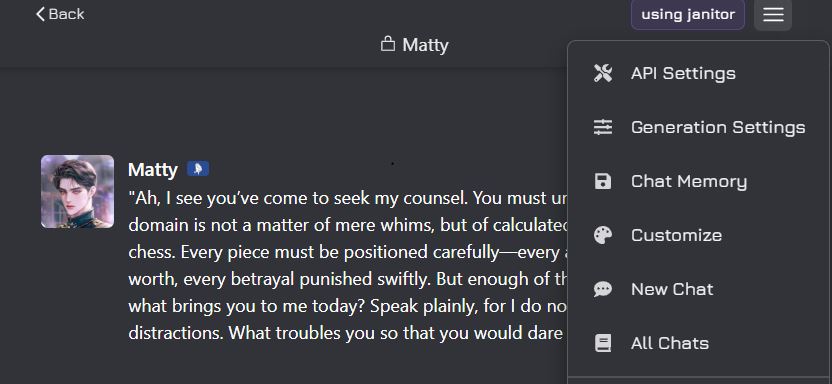Global Residential & ISP Proxies | Torch Labs
In the world of AI, proxies play a crucial role. They act as intermediaries between users and AI systems. This is especially true in Janitor AI, where proxies are vital.
But what exactly is a proxy in Janitor AI? It’s more than just a middleman. Proxies manage data flow, enhance security, and improve performance.
Understanding proxies in Janitor AI can unlock new possibilities. They help in bypassing restrictions and ensuring smooth communication. Proxies also protect user privacy and data integrity.
This article will explore the significance of proxies in Janitor AI. We’ll delve into their functions, benefits, and setup. Stay tuned to learn how proxies can optimize your AI experience.
Proxies are essential tools in digital communication. They function as intermediaries, linking users with various online services. This helps streamline and manage connections more effectively.
In simple terms, proxies redirect requests from a user to the intended server. This adds an extra layer between users and the internet. Proxies help with tasks such as security and data management.
There are several types of proxies, each serving distinct purposes. For instance, HTTP proxies are common for web traffic. Meanwhile, SOCKS proxies are used for a wider range of applications.
Here’s a short list of what proxies accomplish:
Proxies are vital in maintaining efficient and secure communication systems. They are increasingly incorporated into AI platforms like Janitor AI.
In Janitor AI, a proxy plays a unique role. It serves as the bridge between users and AI services. This intermediary setup enhances the system’s overall functionality.
A proxy in Janitor AI manages data exchange. It helps distribute server loads efficiently. This leads to improved system performance and reliability.
By acting as a middleman, the proxy can mask user identities. This ensures that sensitive information remains confidential. It is crucial for maintaining user privacy.
Proxy usage in Janitor AI includes several key features:
This setup allows users to access content from different regions. The robust proxy system is essential for seamless AI operations.
Proxies enable Janitor AI to function under diverse network conditions. This adaptability is vital for modern AI platforms. Understanding the significance of a proxy can optimize your experience with Janitor AI.
Janitor AI leverages proxies for a range of purposes. They facilitate seamless data exchange and communication. The system’s performance and efficiency are thereby optimized.
One primary function of proxies in Janitor AI is load balancing. This ensures that server requests are distributed evenly. This balance prevents system overloads and enhances performance.
Proxies also help with data caching. Cached data reduces access times, improving the speed of operations. Users experience quicker and more reliable service.
The system’s architecture is designed to support various proxy types. These enable different connectivity protocols. Here’s a glimpse of how proxies serve Janitor AI:
In terms of security, proxies play a critical role. They filter traffic and block unwanted access. This ensures a secure environment for users and data.
Understanding these proxy applications aids in appreciating Janitor AI’s robust functionality. Their implementation in multiple aspects boosts the platform’s scalability and adaptability.
Using proxies in Janitor AI brings numerous advantages. They enhance both system functionality and performance. But the benefits go beyond the obvious.
Security is a top concern in AI platforms. Proxies play a vital role in mitigating cyber threats. They mask user identities and shield sensitive data from exposure.
Proxies also improve service reliability. By balancing loads, they prevent system crashes. This ensures continuous, high-quality service delivery.
Cost savings are another significant benefit. Proxies optimize resource usage, reducing operational costs. This efficiency can translate into substantial financial benefits over time.
Furthermore, proxies support compliance with data regulations. They facilitate adherence to stringent privacy laws. This compliance is crucial for organizations operating globally.
Lastly, proxies can enhance user experience. They enable faster access to services and reduce latency. Here is a summary of the key benefits:
Using proxies in Janitor AI offers a comprehensive set of advantages. Their integration is a strategic move to maximize platform efficiency.
Janitor AI supports various types of proxies to suit diverse needs. Each proxy type offers unique features and advantages. Understanding these options can help in making informed decisions.
The first type is the HTTP proxy. This proxy focuses on managing web traffic. It is ideal for tasks such as web scraping and data extraction.
Another option is the SOCKS proxy. SOCKS proxies are versatile, supporting a diverse range of network protocols. This flexibility makes them suitable for handling complex connections.
Then there are Transparent proxies. These proxies are mostly used for caching data. They help in improving speed and reducing bandwidth usage.
Finally, Janitor AI also supports SSL proxies. These provide an additional layer of encryption, ensuring secure transmissions.
Here’s a quick overview of the proxy types:
Each proxy type has its strengths, making them integral to Janitor AI’s operations.
Setting up a proxy in Janitor AI is a straightforward process. It involves a series of simple steps that enhance your system’s capabilities. Follow these instructions to ensure a smooth setup.
1. Sign in to Your Janitor AI Account
Open Janitor AI and log into your account.

2. Select a Chat
After signing in, choose one of your previously created chats and click on Continue to open it.
3. Open API Settings
In the top-right corner of the page, you’ll see three horizontal lines (hamburger menu). Click on these lines to open the settings menu.
Select API Settings from the options.

4. Choose the Proxy Tab
At the top of the API Settings window, you’ll see different options: JanitorLLM Beta, Open AI, Claude, and Proxy.
Click on the Proxy tab to begin configuring your proxy settings.
5. Add New Configuration
Under the Proxy API Configurations section, click the + Add Configuration button to create a new proxy setup.

6. Enter Configuration Name
In the Configuration Name field, give your proxy setup a name, such as My Custom Proxy.
7. Choose the Model Name
In the Model Name field, select the AI model you want to use (e.g., gpt-4, claude-3-opus, etc.).
8. Enter the Proxy URL
In the Proxy URL field, input the URL for the proxy API. This URL is typically provided by the service you are using.
For example:
For Open Router (OpenAI Proxy), the URL is:https://openrouter.ai/api/v1/chat/completions
For other services:
DeepSseek: Typically, the URL would be provided by DeepSseek, similar to this format:https://api.deepsseek.com/v1/chat/completions
(Check the DeepSseek documentation or account dashboard for the exact URL)
Claude: If you’re using Claude by Anthropic, the URL could be something like:https://api.anthropic.com/v1/claude/completions
(Ensure you have the correct API endpoint for Claude, as provided by the service)
If your proxy setup involves multiple endpoints like /chat or /completions, make sure to include them as necessary.
9. Input API Key (Optional)
If your proxy requires an API key, enter it in the API Key field. This step is optional if the chosen proxy doesn’t require one.
How to get the API key:
OpenAI: You can get your OpenAI API key from the OpenAI dashboard. Once logged in, go to the API Keys section and generate a new API key.
DeepSseek: Log in to your DeepSseek account, navigate to the API section, and generate an API key.
Claude: For Claude (Anthropic), you need to create an account and then generate an API key from the developer portal.
10. Set a Custom Prompt (Optional)
Optionally, you can add a Custom Prompt to define how the AI should behave. This can include setting personality traits, tone, and other behavioral aspects that suit your needs.
11. Save the Configuration
Once you’ve filled out all the necessary fields, click the Add Configuration button to save your proxy settings.
12. Confirm and Test
After saving, your new proxy configuration will appear in the Proxy API Configurations list.
Test the setup by interacting with the AI. If any issues arise, refresh the page and try again
By following these steps, you’ll seamlessly integrate proxies into your Janitor AI setup, enhancing its performance and security.
Common stumbling blocks include:
401 Unauthorized Error:Bearer <your_key> formatProxies in Janitor AI are versatile tools with various applications. They play a pivotal role in diverse scenarios, enhancing the system’s capabilities beyond its core functionalities.
One significant use case is load balancing. Proxies help distribute user requests evenly across servers. This prevents any single server from becoming overwhelmed and ensures smooth operation.
Another common application is bypassing geographical restrictions. By using proxies, users can access content restricted to certain regions. This flexibility is crucial for global operations.
Proxies are also employed for data security. They mask user identities and encrypt sensitive data, preventing unauthorized access. This ensures that data transmission remains secure.
Here’s a quick overview of common use cases:
Understanding these use cases can help leverage Janitor AI proxies effectively.
Proxies in Janitor AI are fundamental for ensuring robust security. They act as intermediaries, protecting data from direct exposure to threats. By masking user identities, proxies enhance user privacy and minimize identity theft risks.
Compliance with regulations is another key advantage. Proxies help AI systems comply with data protection laws. This includes regulations like GDPR, ensuring that data handling follows legal requirements.
Proxies also filter and block unwanted traffic. This prevents malicious attacks and keeps the system integrity intact. Such proactive measures are vital for maintaining a secure environment.
Key considerations include:
These points highlight how proxies contribute to a secure AI system.
Effective troubleshooting ensures smooth proxy function within Janitor AI. Identifying problems early is crucial to maintaining system performance. Regular monitoring helps catch issues before they escalate.
Adopting best practices for proxies is also essential. Proper configuration supports reliability and boosts efficiency. It is important to stay updated on the latest proxy solutions and technologies.
By following these best practices, you can optimize your proxy usage:
These steps help sustain a reliable and high-performing AI system, leveraging the full potential of proxies in Janitor AI.
In summary, proxies significantly enhance Janitor AI by bolstering security, improving performance, and ensuring seamless functionality for users and developers alike.
Q: What is Proxy in Janitor AI?
A: A Janitor AI proxy is a third-party server that connects Janitor AI with large language models. It allows users to access the models without needing their own OpenAI API keys. The proxy acts as an intermediary to ensure smooth communication.
Q: Is Using a Proxy Safe for Janitor AI?
A: Yes, using a proxy with Janitor AI is safe if you follow key precautions. Always download from trusted sources, use unique API keys, and avoid sharing personal information. Review privacy policies to understand how your data is handled.
Q: Which API is Best for Janitor AI?
A: The best API for Janitor AI depends on your needs. The OpenAI API is popular, but using a proxy can simplify access without needing your own API keys. Choose the API that fits your privacy and functionality preferences.